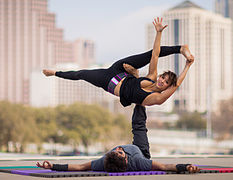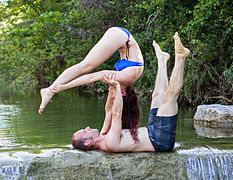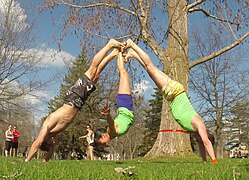Acroyoga

Acroyoga (also written Acro-Yoga or Acro Yoga) is a physical practice which combines yoga, acrobatics and thaimassage.
Acroyoga is more vigorous than many traditional yoga practices and may lead to more injuries.[1]
Acroyoga has been practiced since the beginning of the century. One of the oldest videos of someone doing Acroyoga is with Sri Tirumalai Krishnamacharya, practicing the role of the base, while a child executed some asanas in 1938. Since then, Acroyoga has gained new movements, and is still changing.
Roles
There are three primary roles in an Acroyoga practice: base, flyer, and spotter.[2]
- Base - this is the individual who has the most points of contact with the ground. Often this person is lying on the ground with the entire back torso in full contact. This enables both the arms and legs to be "bone-stacked" for maximum stability and support of the Flyer. Main points of contact with the flyer are the feet (generally placed on the Flyer's hips, groin or lower abdomen) and the hands (which either form handholds or grasp the shoulders).
- Flyer - this is the individual who is elevated off the ground by the Base. The Flyer can move into a series of dynamic positions, and generally lets gravity do the work for them. A Flyer needs balance, confidence, and core strength.
- Spotter - this is the individual who has an objective view of the partners, and whose entire focus is on making sure that the Flyer lands safely in case of any slips. The spotter can also make recommendations to the Base and Flyer to improve their form.
Elements

Acrobatics
is the physical part of Acroyoga that uses gymnastics techniques to build strength, flexibility, trust and teamwork between partners.
In the Acrobatic element we have:
Static poses
Initially basic poses such as bird, throne and whale. When the partners hold the position using equilibrium which is a state of rest or balance due to the equal action of opposing forces.
Acrobatic flying
Focus on movement - first, the flyer and base learn a static pose, later, how to move from one pose to another, creating a movement that is called "transition" in between the two poses.
In the acrobatic flying, there is a sequence of movements that start and end in the same position, which is called washing machine. There are many different washing machines. These basics washing machines that are taught are: barrel roll and ninja star.
Pops
Small jumps where the partners keep physical contact with each other, usually keeping their hands connected.[1]
Yoga
Reflects the physical, mental, and spiritual disciplines of traditional Yoga
Therapeutics

At AcroYoga Inc this includes Thai massage, therapeutic flying and partner yoga.
A basic therapeutic pose is Folded Leaf in which one partner is inverted and supported on the vertical legs of the other partner whose hands are then free for back massage.[3]
Therapeutic flying
The flyer relaxes the body and is guided by the base through some stretches and massage.
To help the flyer to relax, it is crucial to develop trust first, which can be done by practicing the acrobatic flying. Also, it is important that the base has a strong sense of responsibility, care and trust in all the movements that will execute, before start to heal flyers using therapeutic flying techniques.
It can use techniques from different types of massage, having as a result, a deep level of relaxation.
Learning AcroYoga

Learning Acroyoga requires strength training, flexibility training and technique training.[4] Strength training is accomplished through repetition of exercises like push-ups and hand walking. Flexibility training is best done at the end of a session with a partner. Learning good Acroyoga technique takes time and effort and is best learned with an expert teacher.[4] One important Acroyoga technique is called stacking the bones. This involves the base partner keeping arms and legs straight to maximize the weight load on bones rather than muscles to support the flyer.[5]
A typical Acro Yoga session may include:[6]
- Circle ceremony promotes communication and openness
- Warm-up to gradually get your muscles ready for more strenuous exercise
- Partner flow - continue warming up with asanas and stretching with a partner[7]
- Inversions help build trust between the partners[7]
- Flying and acrobatics
Some communities have regular Acro Yoga meetings to provide a place for interested people to come together and practice for free. There are also larger Acro Yoga events such as the annual Divine Play in Portland, Oregon that draw practitioners from a regional or national area.
In the world, there are instructors teaching Acro Yoga in regular classes and workshops.
You can learn Acroyoga by yourself, but it takes time, discipline and responsibility, as you may not know all the techniques that will make the practice safe, for yourself and others.
Poses
There are many static acro yoga poses.[8] A series of acro yoga poses that are repeated in a continuous flow is called a Washing Machine.[9]
- Acro Yoga Poses
-
Front Bird - a basic acro yoga pose
-
Whale
-
Hangle Dangle
-
Back Bird variation
-
Three person balancing pose
-
Star - side view
-
Floating Paschi
-
Throne Pose with base smaller than the flyer.
-
Non L-Basing pose
Legal aspects
In late 2006, AcroYoga Inc. trademarked the word "ACROYOGA" and asserted that the word's first use anywhere was in 2005.[10] However the term had been used since 1999 by Jessie Goldberg and Eugene Poku[11] and their domain, acroyoga.com had been registered since 2005.[12]
See also
References
- ^ Smith, Eva Norlyk (23 March 2013), The Yoga Injuries Debate: How 'Dangerous' Is Yoga, Really?, HuffPost Healthy Living, retrieved 2 February 2014
- ^ Gates, Chee. "Extreme Yoga Poses and Positions". Fitness Magazine. Retrieved 29 April 2014.
- ^ "Partners In Play". Yoga Journal. Retrieved 29 July 2014.
- ^ a b Nemer, Jason and Sauer-Klein, Jenny. AcroYoga Flight Manual, 2008, acroyoga.org
- ^ "FIVE REASONS YOU SHOULD DO ACROYOGA". Pilgrimage of the Heart Yoga. Retrieved 29 July 2014.
- ^ "AcroYoga". Kula Movement. Retrieved April 29, 2014.
- ^ a b Lee, Cyndi (November 2012). "Partner Up". Yoga Journal. Retrieved April 29, 2014.
- ^ "Poses – Alphabetized". acropedia.org. Retrieved 29 July 2014.
- ^ "Washing Machines – Alphabetized". acropedia.org. Archived from the original on 2013-07-18. Retrieved 29 July 2014.
{{cite web}}: Unknown parameter|dead-url=ignored (|url-status=suggested) (help) - ^ "AcroYoga". Legal Force Trademark Search. Retrieved 29 July 2014.
- ^ "About Us". acroyogamontréal. Retrieved 29 July 2014.
- ^ "Who Is Lookup". WhoIs.net. Retrieved 29 July 2014.
External links
- acromaps.com free resource to find groups, classes, and workshops across the globe
- Acropedia.org free resource for photos and video of many poses
- Acromuseum.com photo archive of acrobatic poses
- AcroYogaAustin.org acroyoga safety and etiquette guideines









